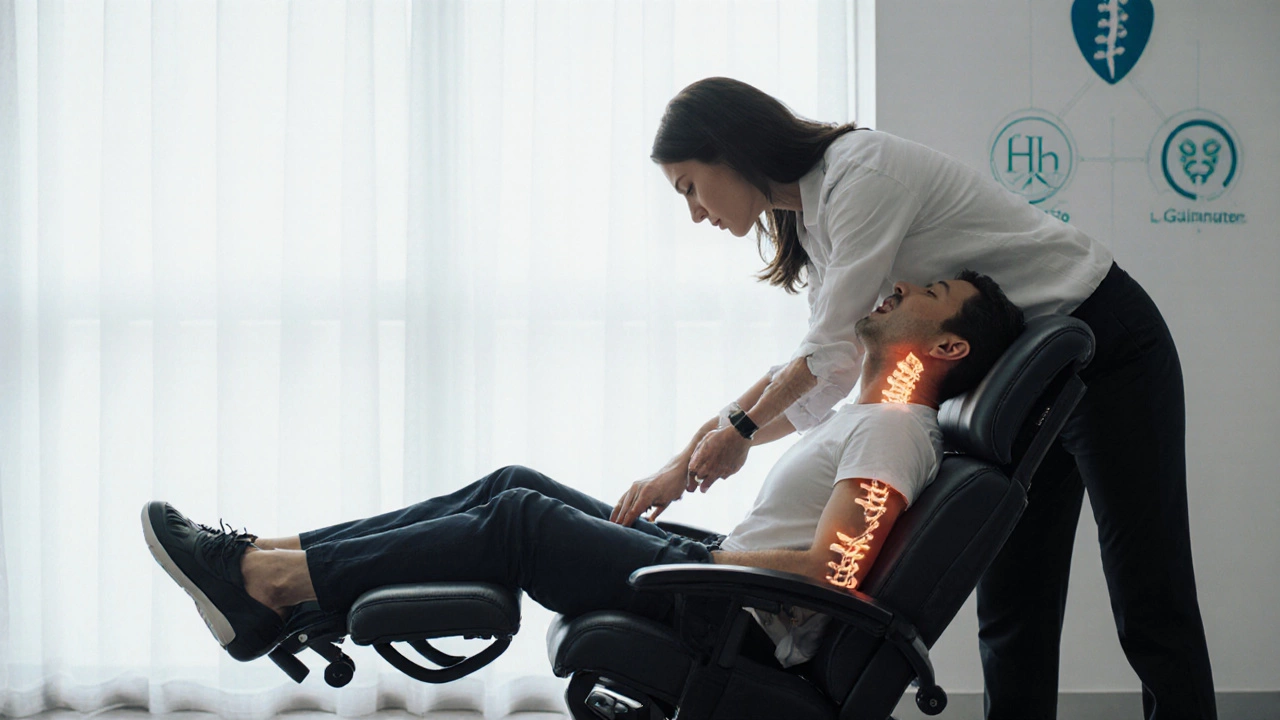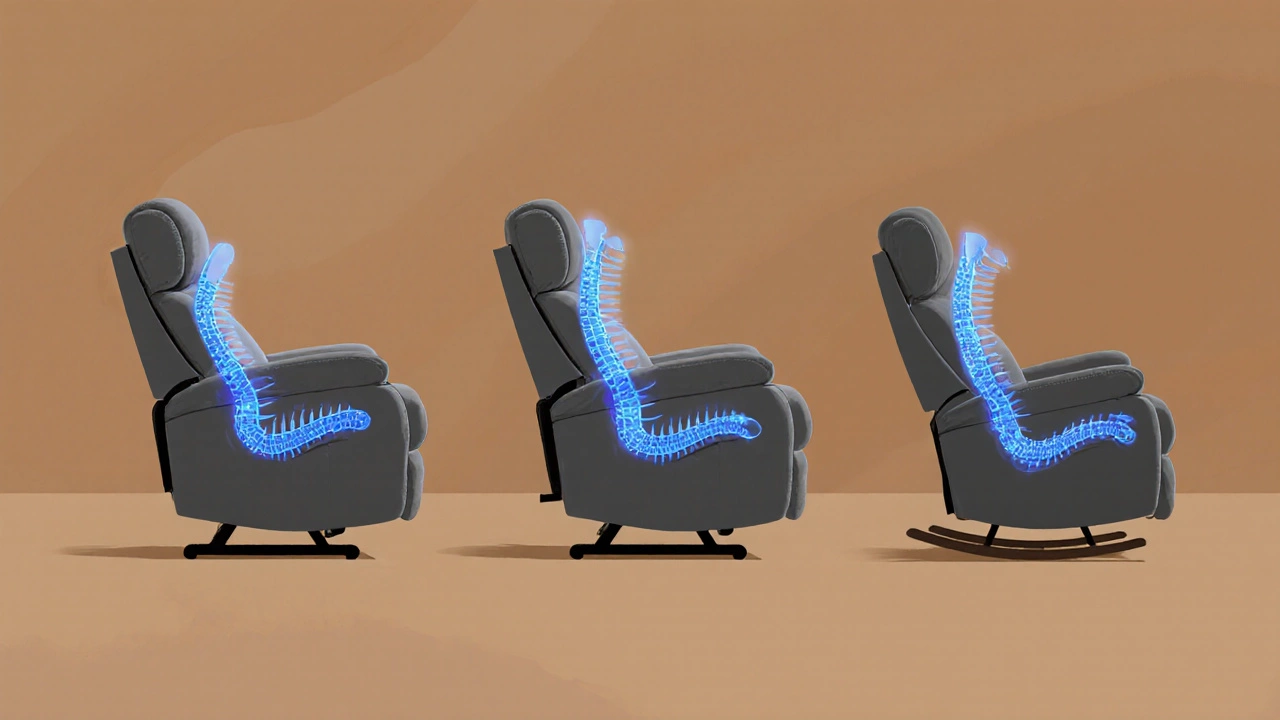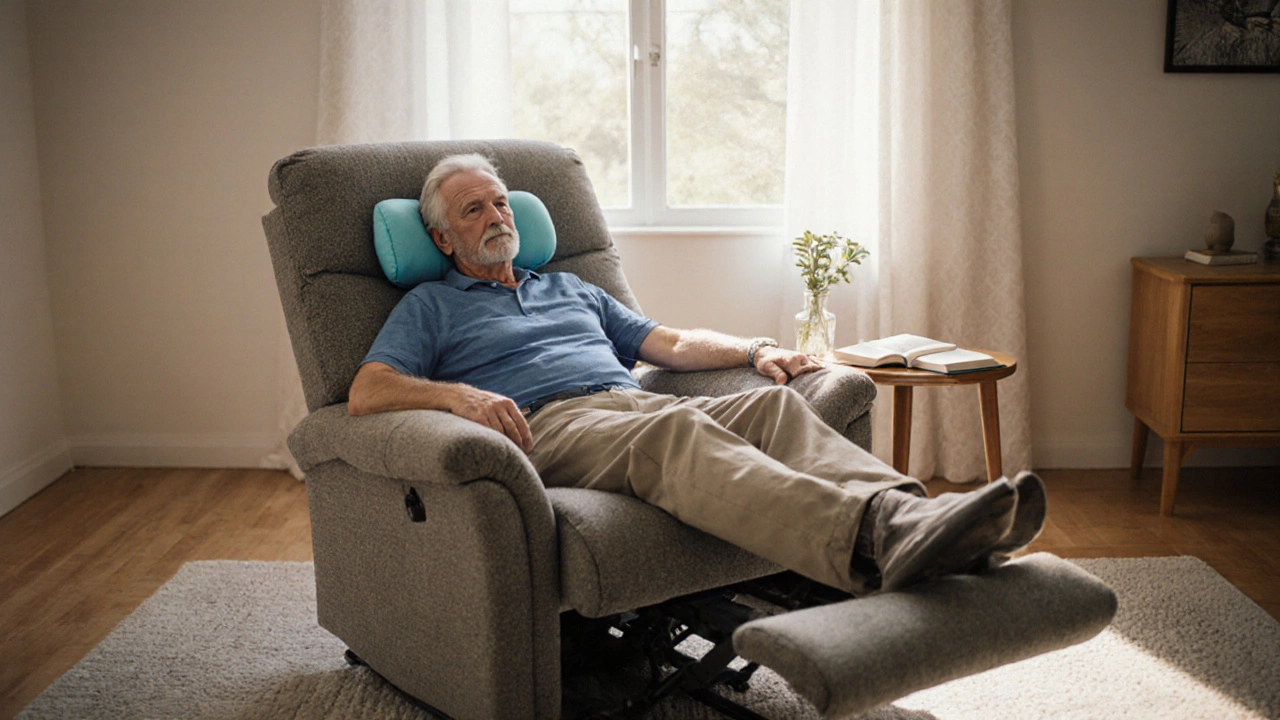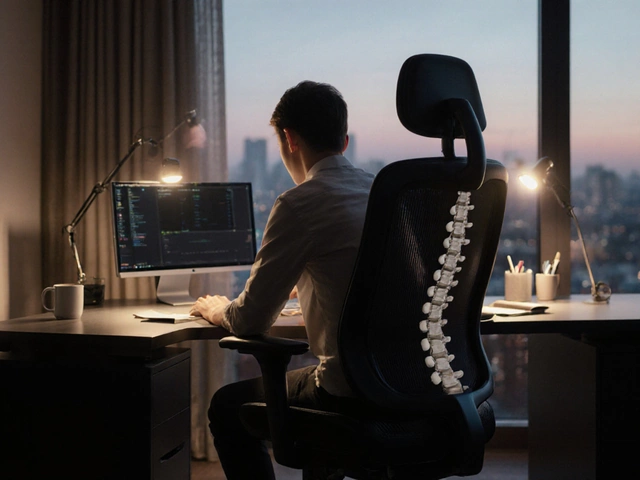Recline Angle Calculator
Based on clinical research, reclining at 135° reduces lumbar pressure by 40% compared to upright sitting. This calculator uses your height and body type to determine the ideal angle for your spinal alignment.
Chiropractors recommend: Keep your knees slightly below your hips and your lower back supported with a natural curve.
If you’ve been told to sit in a recliner for your back pain, you’re not alone. Millions of people turn to recliners to ease discomfort, but not all recliners are created equal. A poorly designed one can make things worse. So what kind of recliner does a chiropractor actually recommend? It’s not about brand names or fancy features-it’s about support, alignment, and movement.
Why Recliners Matter for Back Health
Most people sit for 8 to 10 hours a day-on couches, office chairs, or car seats. That’s a lot of pressure on the spine. When you sit upright without support, your lower back (lumbar spine) flattens out. That puts strain on the discs, ligaments, and muscles. Over time, this leads to chronic pain, muscle fatigue, and even nerve irritation.
A good recliner fixes this by letting you lean back at the right angle. Research from the Journal of Manipulative and Physiological Therapeutics shows that sitting at a 135-degree angle reduces pressure on the lumbar spine by up to 40% compared to a 90-degree upright position. That’s why chiropractors push recliners over regular chairs. But only if they’re built right.
Key Features Chiropractors Look For
Chiropractors don’t recommend one single model-they recommend features. Here’s what they check for:
- Lumbar support that fits the natural curve of your lower back, not just a padded bump
- Adjustable recline angles so you can find your sweet spot between 110 and 135 degrees
- Footrest that extends fully to support your legs without lifting your hips
- High backrest that supports your shoulders and upper back, not just your head
- Zero-gravity positioning (optional but helpful)-this elevates your legs above your heart, reducing spinal compression
Many recliners advertise “ergonomic” but only offer shallow lumbar padding or a fixed position. That’s not enough. Look for models with adjustable lumbar pillows that you can slide up and down to match your spine’s curve. If you can’t adjust it, it won’t work for you.
What to Avoid
Not all recliners help. Some actually hurt. Here’s what to skip:
- Recliners with no lumbar support-these are often cheap, overstuffed, and sink you into a C-curve
- Recliners that tilt too far back-beyond 150 degrees, your pelvis rolls backward, flattening your spine again
- Fixed-position recliners-if you can’t change the angle, you’re stuck in one posture
- Recliners with low footrests-if your feet dangle or your knees are higher than your hips, it pulls your lower back out of alignment
One common mistake? Buying a recliner based on looks. A sleek, modern design might look great in a showroom, but if the backrest is too short or the seat is too shallow, it’s doing more harm than good.
Top Recliner Types Recommended by Chiropractors
There are three main types of recliners chiropractors consistently recommend:
1. Manual Recliners with Adjustable Lumbar
These are the most popular for good reason. You control the recline with a lever or handle. They’re reliable, affordable, and often come with removable lumbar pillows. Brands like La-Z-Boy’s Relaxation Collection and Ethan Allen’s Motion Collection offer models with deep, contoured lumbar support that you can move to fit your spine.
2. Power Recliners with Zero-Gravity Mode
If you have chronic pain or mobility issues, power recliners are worth the investment. They let you adjust the backrest and footrest with a button. The best ones include a zero-gravity setting, which lifts your legs slightly above your heart. This reduces pressure on your discs and improves circulation. Models like the HomCom Power Recliner and Cozzia Dual Motor Recliner have been recommended in clinical studies for patients with herniated discs and sciatica.
3. Rocker Recliners
For seniors or people with arthritis, rocker recliners are a quiet favorite. The gentle rocking motion helps loosen stiff joints and encourages movement. The rocking action isn’t just soothing-it’s therapeutic. Studies from the University of Michigan show that rhythmic motion reduces muscle tension and improves spinal mobility. Look for models with firm cushioning and high back support, like the Herman Miller Renew Rocker.

Real-World Examples: What Works
Take Sarah, 62, who had sciatica for three years. She tried cushions, physical therapy, and even acupuncture. Nothing helped until she switched from a flat sofa to a power recliner with zero-gravity and adjustable lumbar. Within two weeks, her pain dropped from an 8/10 to a 3/10. She now uses it daily for reading and watching TV.
Or James, 48, who sits at a desk all day. He bought a manual recliner with a deep seat and high back. He uses it after work to decompress. His chiropractor told him to recline at 125 degrees and keep his feet flat on the footrest. That’s it. No magic, just alignment.
How to Test a Recliner Before Buying
Don’t just sit in it for 30 seconds. Test it like a chiropractor would:
- Sit in it fully reclined. Can you place your hand behind your lower back? There should be a small, natural curve-not a gap, not a bulge.
- Adjust the footrest. Your knees should be slightly lower than your hips. If your feet dangle, it’s too short.
- Lean back slowly. Does your head rest naturally on the headrest? If you have to crane your neck, the back is too low.
- Stand up. Does it feel like your spine is still aligned? If you feel a sudden pull or twist, skip it.
- Try it for 10 minutes. If you start shifting or adjusting constantly, it’s not right.
Many stores let you test recliners for 15-30 minutes. Use that time. Don’t rush.
Price Range and Value
You don’t need to spend $3,000. A good manual recliner with proper lumbar support starts around $500. Power recliners with zero-gravity start at $800. But here’s the catch: a $300 recliner with no adjustability will cost you more in doctor visits, physical therapy, and lost productivity.
Think of it like shoes. You wouldn’t buy worn-out sneakers for a marathon. Don’t buy a recliner that doesn’t support your spine for 8 hours a day.

Who Should Skip Recliners
Not everyone benefits. If you have severe spinal stenosis, recent spinal surgery, or significant osteoporosis, a recliner might not be enough. Some patients need specialized orthopedic seating, like tilt-in-space wheelchairs or custom-molded cushions. Always check with your chiropractor or physical therapist first.
Also, avoid recliners if you’re using them as a sleep substitute. Sleeping in a recliner long-term can cause hip and neck misalignment. Use it for rest, not rest.
Final Checklist: Your Recliner Must Have
Before you buy, run through this:
- ✅ Adjustable lumbar support you can move up and down
- ✅ Recline angle between 110° and 135°
- ✅ Footrest that fully supports your legs without lifting your hips
- ✅ High backrest that supports your shoulder blades
- ✅ Firm, not overly soft, cushioning
- ✅ Ability to sit upright without sinking
If it checks all these boxes, you’ve found a chair that doesn’t just sit you down-it helps you heal.
Do chiropractors recommend power recliners?
Yes, especially for people with chronic back pain, arthritis, or limited mobility. Power recliners with zero-gravity positioning reduce spinal pressure and help with circulation. They’re particularly useful for those who struggle to adjust their position manually. But manual recliners with good lumbar support are just as effective if you’re able to move them yourself.
Is a zero-gravity recliner worth the extra cost?
If you have lower back pain, sciatica, or swelling in your legs, yes. Zero-gravity positioning lifts your legs above your heart, which reduces pressure on your discs and improves blood flow. Studies show it can reduce lower back pain by up to 60% in 30 minutes. The extra cost-usually $200-$500 more than standard recliners-is often offset by fewer chiropractic visits and less pain medication.
Can I use a recliner if I have a herniated disc?
Yes, but only if it supports your lumbar curve and keeps your spine in neutral alignment. Avoid recliners that let you sink too far back. A recliner with adjustable lumbar and a 120-130 degree recline angle is ideal. Many patients with herniated discs report less pain when using a recliner compared to upright chairs. Always avoid sudden twisting or bouncing motions.
How long should I sit in a recliner each day?
There’s no hard rule, but 2-4 hours total per day is ideal for pain relief. Use it for rest, reading, or watching TV-not as a replacement for movement. Get up every 30-45 minutes to walk around, stretch, or do a simple spinal reset. Sitting too long-even in the best recliner-can still stiffen your muscles.
What’s the difference between a recliner and a massage chair?
A massage chair is designed for relaxation and muscle stimulation, not spinal alignment. Many massage chairs have poor lumbar support and push your spine into unnatural curves. A chiropractor-recommended recliner focuses on posture, support, and neutral spine positioning. You can have both-a recliner for daily support and a massage chair for occasional relief-but don’t confuse the two.
Are leather recliners better than fabric ones?
Material doesn’t affect spinal support. What matters is the internal frame, cushion density, and lumbar design. Leather may feel more premium and is easier to clean, but fabric often allows better breathability and grip (so you don’t slide). Choose based on comfort and climate-not marketing claims.
Should I get a recliner with a headrest that moves?
It helps, especially if you’re tall or have neck pain. A fixed headrest might leave your neck unsupported when reclined. An adjustable headrest lets you align your head with your spine, reducing strain on your neck muscles. Look for models with at least 2-3 inches of vertical adjustment.
Next Steps
Start by measuring your space. Recliners need room to lean back-usually 18-24 inches from the wall. Then, visit a store and test at least three models using the checklist above. Don’t buy online without testing first. Your spine will thank you.





